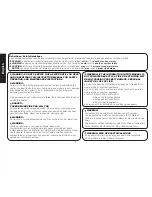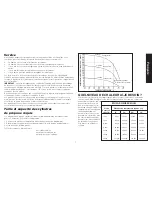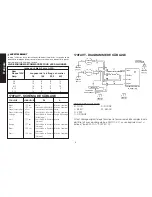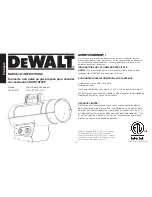
E
ng
lish
7
Servicing
A hazardous condition may result if a heater is used that has been modified or is not
functioning properly. When the heater is working properly:
•
The flame is contained within the heater.
•
The flame is essentially blue with perhaps some yellow tipping.
•
There is no strong disagreeable odor, eye burning or other physical
discomfort.
•
There is no smoke or soot internal or external to the heater.
•
There are no unplanned or unexplained shut downs of the heater.
The parts lists and wiring diagram show the heater as it was constructed. Do not
use a heater which is different from that shown. In this regard, use only the hose,
regulator and cylinder connection fitting (called a POL fitting) supplied with the heater.
IMPORTANT
Match the color stripe on the hangtag attached to the hose assembly
with the color on the label located near the propane inlet fitting on the heater. Do not
use alternates. For this heater, the regulator must be set as shown in “specifications”.
If there is any uncertainty about the regulator setting, have it checked.
A heater which is not working right must be repaired, but only by a trained,
experienced service person.
In-warranty products will be repaired with no charge for either parts or labor. Please
include a brief statement indicating date, place of purchase, the nature of the problem
and proof of purchase.
Out-of-warrranty products will be repaired with a charge for parts and labor.
Size and Capacity of Propane
Cylinders Required
The charts on the following page show the approximate size of the cylinder
required for these heaters. To use the chart:
1. Select the lowest air temperature expected (at the bottom of the chart).
2. Move straight up to time of operation desired (left side of chart).
3. Read the cylinder size required.
All heaters should have:
full cylinders
good air circulation
no frost on cylinders
HOW MUCH HEAT DO I REQUIRE?
For economy, it is important to match input to that required. But heat requirements
often vary. For example, it usually takes a lot more heat to get things warm than it
does to keep them that
way. Likewise, outside air
temperature usually
changes during the day
so you may need more
heat at night than you
do in the daytime. An
approximation of the heat
required can be found
by using this chart.
Cubic feet
Temperature Rise Required (
o
F)*
of space to
be heated
20
o
30
o
40
o
50
o
5,000
14,000
20,000
27,999
34,000
7,000
19,000
28,000
38,000
47,000
10,000
27,000 40,000 54,000 67,000
15,000
40,000
60,000
80,000
100,000
20,000
54,000
80,000 107,000 133,000
30.000
80,000 120,000 160,000 200,000
50,000 133,000 200,000 266,000 333,000
BTU’S PER HOUR REQUIRED
3 cylinders
2 cylinders
1 cylinder
100# (45.4 kg)
100# (45.4 kg)
100# (45.4 kg)








































